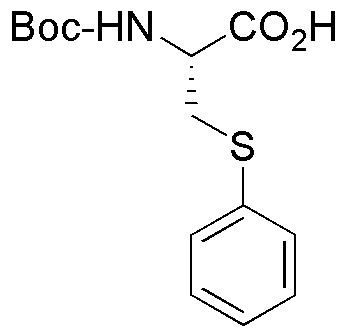(R)-Boc-2-amino-3-phenylsulfanyl-propionic acid is widely utilized in research focused on
- Peptide Synthesis: This compound serves as a valuable building block in the synthesis of peptides, particularly in the pharmaceutical industry, where it can enhance the stability and efficacy of drug candidates.
- Drug Development: Its unique structure allows for the design of novel therapeutics targeting specific biological pathways, making it essential in the development of new medications.
- Bioconjugation: The compound can be used in bioconjugation processes to attach drugs or imaging agents to biomolecules, improving the delivery and targeting of therapies in cancer treatment.
- Research in Neuroscience: It has applications in neuroscience research, particularly in studying neurotransmitter systems, due to its ability to modulate certain receptor activities.
- Analytical Chemistry: This chemical is also employed in analytical methods for detecting and quantifying amino acids in biological samples, aiding researchers in metabolic studies.
General Information
Properties
Safety and Regulations
Applications
(R)-Boc-2-amino-3-phenylsulfanyl-propionic acid is widely utilized in research focused on
- Peptide Synthesis: This compound serves as a valuable building block in the synthesis of peptides, particularly in the pharmaceutical industry, where it can enhance the stability and efficacy of drug candidates.
- Drug Development: Its unique structure allows for the design of novel therapeutics targeting specific biological pathways, making it essential in the development of new medications.
- Bioconjugation: The compound can be used in bioconjugation processes to attach drugs or imaging agents to biomolecules, improving the delivery and targeting of therapies in cancer treatment.
- Research in Neuroscience: It has applications in neuroscience research, particularly in studying neurotransmitter systems, due to its ability to modulate certain receptor activities.
- Analytical Chemistry: This chemical is also employed in analytical methods for detecting and quantifying amino acids in biological samples, aiding researchers in metabolic studies.
Documents
Safety Data Sheets (SDS)
The SDS provides comprehensive safety information on handling, storage, and disposal of the product.
Product Specification (PS)
The PS provides a comprehensive breakdown of the product’s properties, including chemical composition, physical state, purity, and storage requirements. It also details acceptable quality ranges and the product's intended applications.
Certificates of Analysis (COA)
Search for Certificates of Analysis (COA) by entering the products Lot Number. Lot and Batch Numbers can be found on a product’s label following the words ‘Lot’ or ‘Batch’.
*Catalog Number
*Lot Number
Certificates Of Origin (COO)
This COO confirms the country where the product was manufactured, and also details the materials and components used in it and whether it is derived from natural, synthetic, or other specific sources. This certificate may be required for customs, trade, and regulatory compliance.
*Catalog Number
*Lot Number
Safety Data Sheets (SDS)
The SDS provides comprehensive safety information on handling, storage, and disposal of the product.
DownloadProduct Specification (PS)
The PS provides a comprehensive breakdown of the product’s properties, including chemical composition, physical state, purity, and storage requirements. It also details acceptable quality ranges and the product's intended applications.
DownloadCertificates of Analysis (COA)
Search for Certificates of Analysis (COA) by entering the products Lot Number. Lot and Batch Numbers can be found on a product’s label following the words ‘Lot’ or ‘Batch’.
*Catalog Number
*Lot Number
Certificates Of Origin (COO)
This COO confirms the country where the product was manufactured, and also details the materials and components used in it and whether it is derived from natural, synthetic, or other specific sources. This certificate may be required for customs, trade, and regulatory compliance.


